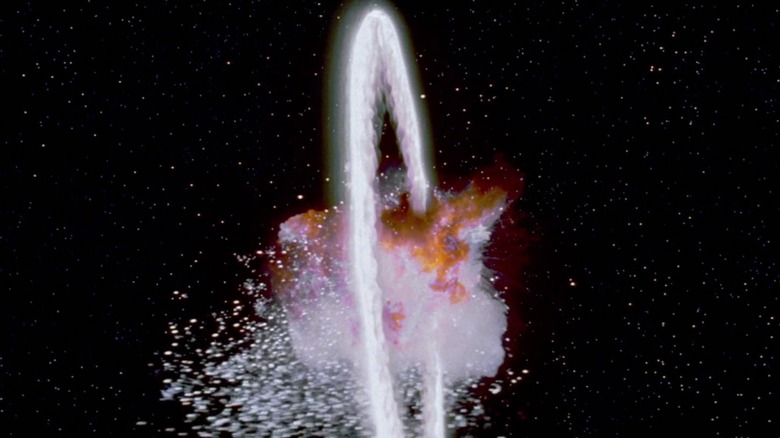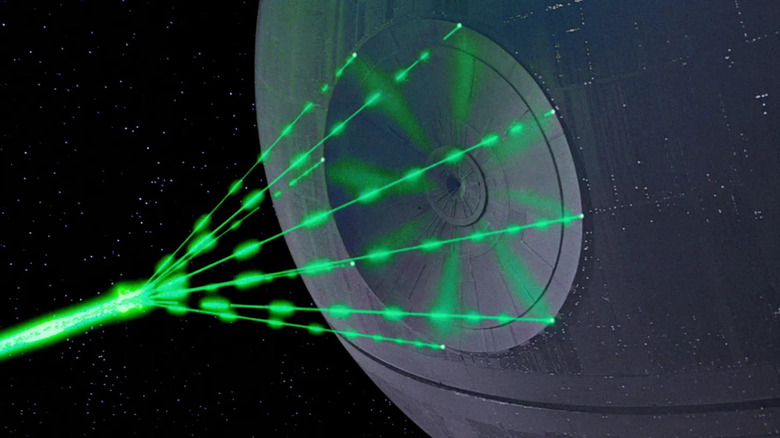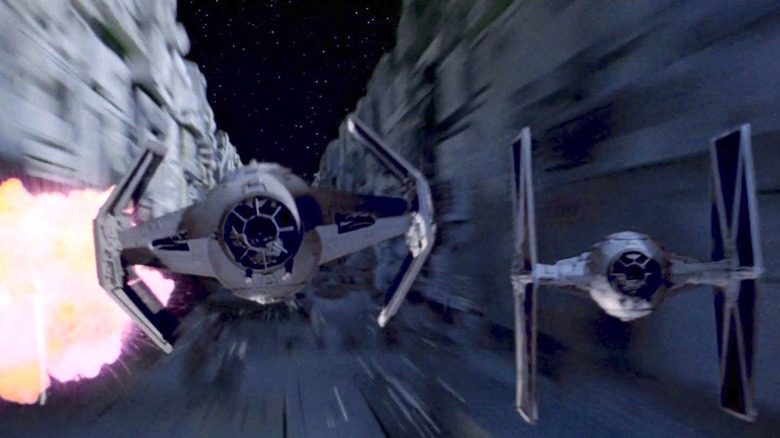Star Wars: A New Hope's Death Star Destruction Scene Almost Looked A Lot Different
During the making of "Star Wars" back in 1976, writer/director George Lucas hadn't really yet defined what the Force was. In dialogue, Obi-Wan Kenobi eventually described it as "an energy field created by all living things. It surrounds us and penetrates us; it binds the galaxy together." In J.W. Rinzler's invaluable book "The Making of Star Wars: The Definitive Story Behind the Original Film," it was indicated that early drafts of "Star Wars" originally called it the Force of Others, and possessed two parts called Ashla (what would become the light side) and Bogan (what would become the dark side). Lucas mixed in a bunch of Platonic notions as well, saying that "the pure soul is connected to a larger energy field that you would begin to understand if you went all the way back and saw yourself in your purest sense."
Additionally, in early drafts of Lucas' script, the story revolved around the magic of a notable kyber crystal, something that would have enhanced Luke Skywalker's ability to tap into the Force and channel it into psychic powers. Kyber crystals, as all Starwoids would be happy to tell you today, are a vital component of lightsabers. During the creation of "Star Wars," however, a kyber crystal was to be the film's central MacGuffin. The final film used the stolen plans for the Death Star instead.
It was between the second and third drafts of "Star Wars" that the kyber crystal took a backseat, and blowing up the Death Star became the main focus of the film's climax. Even then, the original idea for Luke Skywalker's attack was much different. Luke was originally supposed to chuck a bomb into the Death Star's exhaust port by hand.
Swordfight!
The original plot outline, detailed by Rinzler, read thus:
"1) Luke learns about Force (in desert); 2) Luke tries to experience Force (in ship); 3) Luke becomes a man of the Force (Alderaan); 4) Ben explains Luke's experience (in ship); 5) Luke with crystal struggles with Force (on Yavin)."
The first two steps remained in the final draft of the script. Lucas' notes mentioned that kyber crystals were just a conduit for trainees. As Jedi became more powerful, they needed kyber crystals less and less. After the first draft, however, "Star Wars" became less focused on Luke's experience with the Force, and more tuned to the action-packed adventures to get the plans to the Death Star to the Rebel Alliance so they could find a weakness and stage an attack.
Lucas noted the original vision for the Death Star attack was much more hands-on, and that Luke would be carrying a vital new object, the Force crystal, with him when Darth Vader arrived to confront him. He said:
"Between the second and third drafts, Luke stopped on the surface on the Death Star. He and Artoo had to go and take the bomb by hand, open up the little hatch, and drop the bomb in it — then they had 15 seconds or something to get off the surface before the thing blew up — but as they were going back to the ship, Darth Vader arrived."
Lucas admits that such a scene would have killed the pace, continuing:
"Luke and Vader had a big swordfight. Luke finally overcame Vader and then jumped in the ship and took off. But in trying to intercut the dogfight with the old-fashioned swordfight, I realized that the film would have just stopped dead. It was too risky."
Instead, Luke stayed on his X-wing.
Not a story guy
Given how so many modern conversations about "Star Wars" mention its ancient storytelling tropes, its plot, and its solid Hero's Journey structure, Lucas admitted that he wasn't initially concerned with the plot. Looking at his previous two movies, "THX 1138" and "American Graffiti," one sees two mood pieces, films about a world and the incidental things that happen in them. Lucas admitted that these movies, by design, weren't stringently plotted. Well-structured, perhaps, but not plotted. Lucas describes his instincts thus:
"I feel that I'm fairly decent at construction, not necessarily plot, but construction. [...] Neither 'Graffiti' nor 'THX' had plots. I'm not really interested in plots. That's one of the problems I've had with this movie: it's a plotted movie. And I find plots boring because they're so mechanical. You go from here to there, and once you know what's going to happen, that's it. And I just am not enthralled with that kind of action. I'm much more into the scenes and the nuances of what's going on. I find that fascinating."
Taking all the information above in a lump, one might sense that Lucas was trying, when he was making "Star Wars," to develop a laidback, spiritual story that was merely extrapolated from the "Flash Gordon"-inspired sci-fi he so loved. As he discovered the film's structure, though, plot began to come forward, and audiences found the carefully constructed film we can still see to this day. Somewhere inside Lucas, one might find a disappointed artist who wasn't able to make the headier, religious parable he originally wanted.
Perhaps that film is still in Lucas' future.


